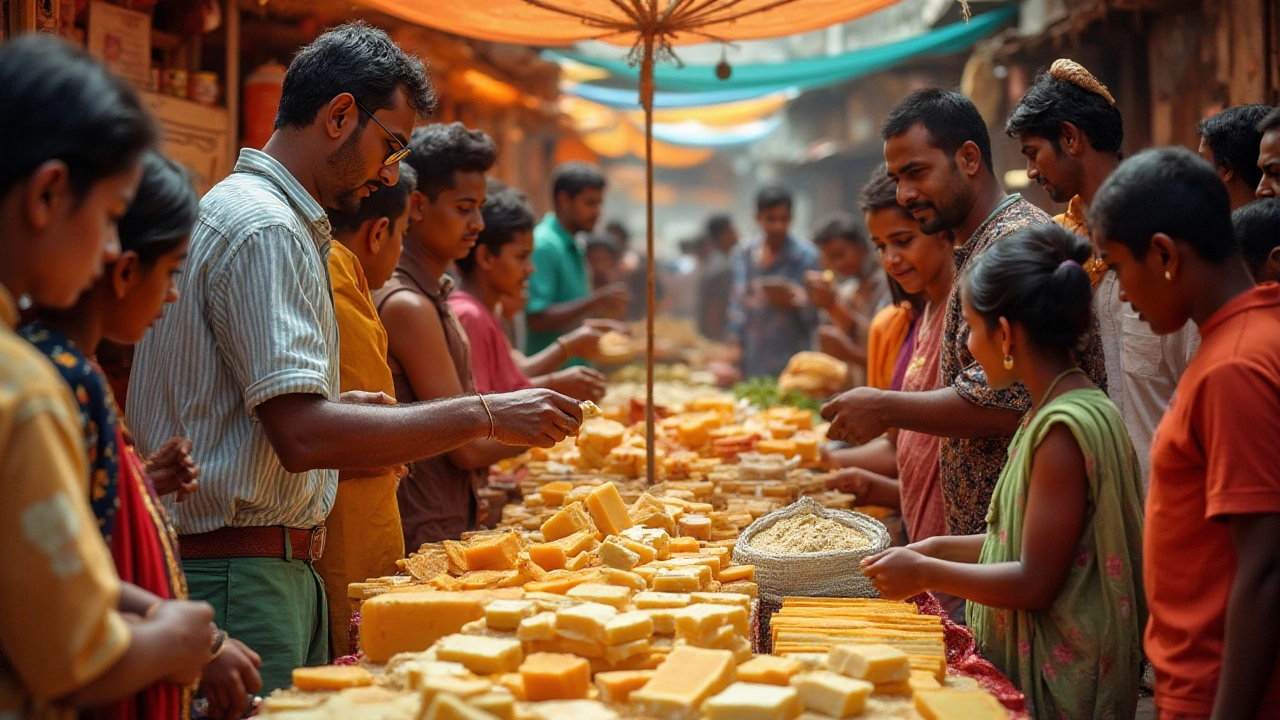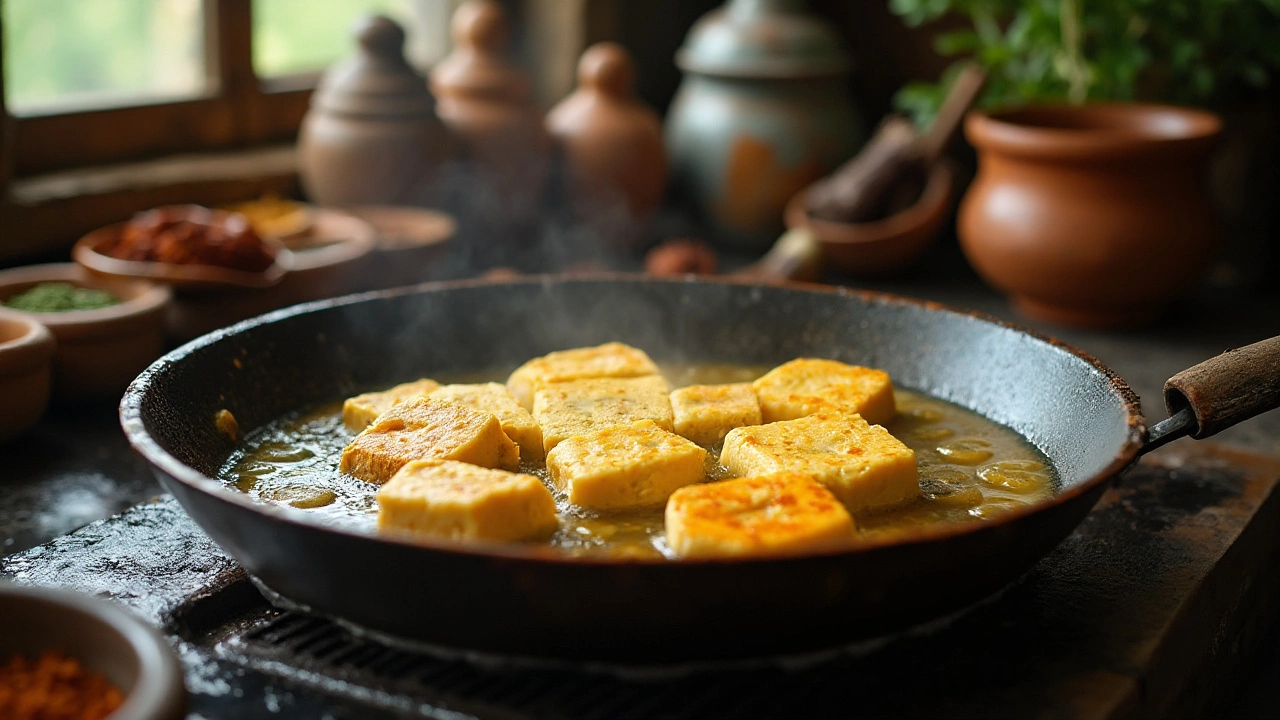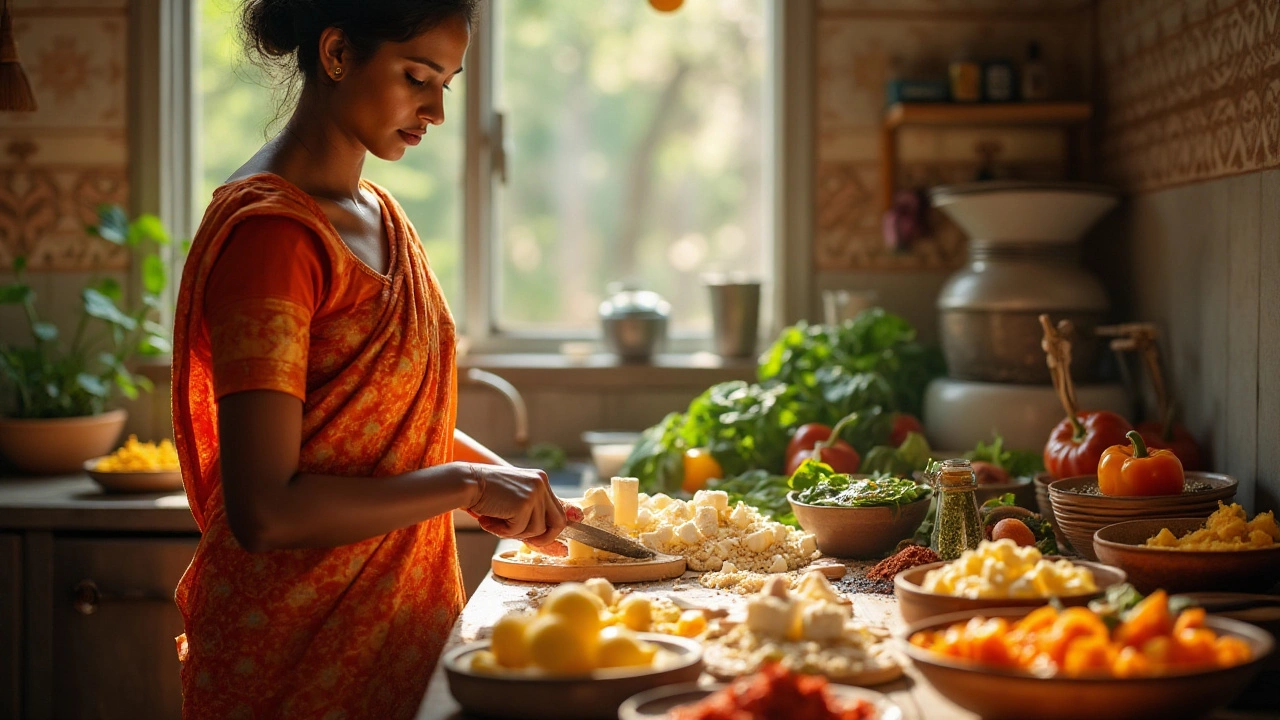Paneer is a beloved staple in various Indian dishes, cherished for its soft texture and delightful ability to absorb flavors from spices and sauces. Yet sometimes, replicating this ingredient poses a challenge when it's not readily available. There’s good news for cheese enthusiasts, though! Several cheeses exist that mirror paneer's characteristics, making them fantastic substitutes in the kitchen.
Seeking alternatives involves recognizing the essence of paneer—its non-melting nature, fresh taste, and crumbly yet firm structure. With this knowledge, we delve into a world of cheeses, each bringing their own charm, to find those that come closest to the real deal.
- Understanding Paneer: Unique Qualities
- Exploring Cheese Alternatives to Paneer
- Cooking Tips for Cheese Substitutes
- Culinary Uses for Paneer and Its Alternatives
- Interesting Facts About Cheeses Similar to Paneer
Understanding Paneer: Unique Qualities
Paneer, often heralded as a culinary masterpiece in Indian cuisine, stands out not only for its taste but also for its unique characteristics. What sets paneer apart from many other cheeses is its fresh, unaged, and acid-set nature, which contributes to its soft yet firm texture. It does not undergo the traditional rennet-curdling process, making it vegetarian-friendly and aligning with various dietary preferences. Paneer's simple making process involves boiling milk and then curdling it using acidic agents like lemon juice or vinegar, a practice commonly followed in homes across India. This method, ancient and time-honored, ensures that paneer retains its natural flavors, making it a versatile addition to diverse dishes where it can either blend in seamlessly or become the star of the show.
The texture of paneer is what makes it such a delightful addition to recipes. Unlike many other cheeses, paneer does not melt when heated. This is due to its high protein but low-fat content, allowing it to maintain its shape during cooking. Consequently, paneer can be grilled, sautéed, or fried without losing its form, making it an excellent choice for main dishes and appetizers alike. Its ability to absorb and enhance the flavors of spices and gravies makes it more than just an accompaniment; it becomes an integral part of the meal. This attribute is particularly cherished in Indian households, where it features prominently in dishes like palak paneer and paneer tikka.
Another intriguing aspect of paneer is its nutritional profile. It is a rich source of protein, particularly valuable for vegetarian diets. Alongside its protein content, paneer provides essential fats, calcium, and vitamins such as vitamin D and B12. This makes it not only a nutritious choice but also a filling one. In fact, a study published in the "Journal of Dairy Science" notes, "Paneer's high protein-to-fat ratio makes it an attractive option for those seeking to maintain balanced nutrition without compromising on taste." Social events or festive occasions are often incomplete without paneer-based dishes taking center stage, loved by both children and adults alike.
Pushing the boundaries of traditional meals, paneer has gracefully crossed borders to inspire international chefs, leading to creative adaptations of classic recipes. Many Western chefs embrace paneer's ability to partner well with international ingredients, opening up an array of fusion possibilities that delight the palate. Its simple production process and the absence of additives or preservatives make homemade paneer a healthier choice than many commercial cheeses available in stores. Moreover, directly controlling the ingredients allows for adjustments in dietary restrictions, such as reduced salt intake or organic sourcing.
In summary, paneer's versatility is truly unparalleled, attributed to its easy preparation, health benefits, and culinary adaptability. It's this melding of simplicity with potential that makes paneer not just a staple in Indian kitchens but a delightful discovery for anyone willing to explore. Recognizing the sheer comfort it offers, there has been a surge in its popularity worldwide, shining a light on its myriad uses both in traditional and contemporary cooking. As culinary landscapes continue to evolve, paneer's charm only stands to grow, tantalizing taste buds across the globe.
Exploring Cheese Alternatives to Paneer
In the quest to find paneer alternatives, it is important to uncover cheeses that share its delightful properties. One such cheese that often comes to mind is Ricotta. This Italian wonder, traditionally used in lasagnas and pastries, is surprisingly similar to paneer when pressed and drained. It carries a mild flavor and crumbly texture that, when handled correctly, can substitute for paneer in many beloved recipes. The key to using ricotta as a paneer stand-in lies in removing excess moisture and letting it firm up to match the paneer's structure.
Another contender in the list of cheese like paneer is Queso Fresco. This Mexican cheese, often seen crumbling over tacos and salads, stands out for its fresh, slightly tangy taste. Its unique ability to soften rather than melt makes it a great alternative for those spicy curries and palatable gravies where paneer shines. As with paneer, Queso Fresco absorbs the ambient flavors, giving your dishes an exotic twist while maintaining that familiar texture.
Those who favor a more Mediterranean approach may find Halloumi to be a fascinating choice. Known for its semi-hard, grill-ready nature, Halloumi can mimic paneer in ways that emphasize its versatility. Although Halloumi has a saltier profile, it’s an excellent ingredient in pan-fried or grilled dishes where paneer's unyielding quality is desired. The crispy crust it forms on the outside with its soft interior can turn any dish into a delightful experience.
"The pressing and draining method common in ricotta preparation is a game-changer for those seeking paneer-like textures in alternate cheeses," says culinary expert Anjali Gupta.For lighter dishes, look to Cottage Cheese. When drained thoroughly, it offers a slightly bland yet creamy texture that pairs well in saag paneer or as a protein-packed addition to salads. Though it lacks paneer's firmness, its nutritional benefits and easy availability make it a neat fit for some dishes where the richness of paneer might be too overwhelming.
Finally, let’s not forget about the humble Farmer Cheese. Often overlooked, its simplicity and ease of preparation at home bring it close to replicating the experience of making paneer. Both cheeses start from the foundation of fresh cow’s milk through curdling processes, leading to similar results when it comes to flavor and texture, allowing for seamless transitions in recipes traditionally dedicated to paneer.

Cooking Tips for Cheese Substitutes
Substituting cheeses like paneer in your recipes requires more than just finding a replacement with similar texture. The key is understanding how these substitutes behave under heat and how they interact with other ingredients to maintain flavor authenticity. Cheeses such as ricotta, cottage cheese, and queso fresco often come up as potential alternatives. But here's where it gets interesting: their moisture content and aging process significantly impact the culinary result, demanding slight alterations in preparation techniques.
When opting for ricotta, its higher moisture calls for a cautious approach. Consider partially draining ricotta using a cheesecloth to achieve a consistency closer to the firmness of paneer. Cottage cheese, on the other hand, benefits from a bit of pressing, allowing its curds to firm up. A clean kitchen towel can help absorb excess liquid, or you might want to try lightly salting the cheese and letting it sit for an hour before rinsing away the salt, which helps draw out moisture. These small but vital modifications ensure your dish doesn't become overly watery and stays true to its intended consistency.
Cheese like paneer, such as queso fresco, offers a crumbly, yet slightly firmer texture which can be enhanced when added to slow-simmered curries or stir-fried into vegetables. Avoid extra sharp flavors that might overshadow delicate spices, keeping the integrity of the dish intact. One practical tip is to add cheese substitutes towards the end of cooking. This prevents overcooking, helping to maintain the desired texture and allowing the cheese to gently absorb surrounding flavors rather than dissolve into the dish.
Additionally, incorporating cheese substitutes into traditional paneer dishes like palak paneer or shahi paneer means adjusting seasoning slightly. These cheeses, unlike paneer, can have subtle flavor undertones, so a delicate use of spices can create a harmonious balance. Adjusting your palate to account for these minor taste differences ensures your culinary creation retains the satisfaction paneer offers. And let's not forget presentation. A uniformly cubed cheese substitute mirrors paneer's visual appeal, giving your dish an authentic look.
"Cheese, when used creatively, offers a fascinating playground for flavors. No substitute diminishes the art but rather contributes to a new interpretation," says culinary expert Harjeet Kaur, highlighting the joy found in cheese exploration.Embracing experimentation with varied milk-based products opens doors to exciting taste dimensions. Try grilling your cheese substitute before adding it to soups or salads to introduce a delightful smokiness. Alternatively, marinate cubes in herbed oils or dressings, inviting nuanced depths to each bite. These innovations not only replicate paneer's essence but often elevate it, turning a simple dish into a gastronomic delight.
Culinary Uses for Paneer and Its Alternatives
In the world of gastronomy, paneer stands out for its versatility and ability to harmonize with a variety of dishes. Known for its spongy texture and the way it perfectly absorbs spices, it's a favorite in curries, grilled dishes, and even desserts. When seeking alternatives, you want a cheese that can mimic these properties. For instance, Halloumi is an excellent stand-in when you need a cheese that holds its shape during cooking. It works beautifully in a skillet or on the grill, much like paneer. Some might argue that in its magical willingness to adapt, paneer is unparalleled. As noted by food historian K.T. Achaya, paneer’s transformation from the undemanding milk to culinary delight is nothing short of genius.
Chefs often utilize cheese like paneer, such as queso blanco or cottage cheese, for those creamy gravies where the cheese needs to soak up the rich flavors. Imagine a sumptuous saag paneer dish, with the leafy greens enveloping softened, tender cubes of cheese. Here, queso blanco can act as a stellar substitute, standing up to the robust tastes without losing form. Its mild flavor pairs well with spices like cumin and coriander, adding depth without overshadowing the dish's primary elements.
Delving into street food, paneer finds its place in skewers and wraps. Enter feta, which, although more crumbly, lends its tangy notes to salads and can add a Mediterranean twist to Indian-inspired dishes. Pair it with fruits or fresh herbs like mint and your taste buds embark on a delightful journey. A feta and watermelon salad with a drizzle of balsamic reduction can be a refreshingly unexpected counterpart to paneer dishes. Did you know that over 70% of Indian cheese dishes include paneer in some way, often accompanied by spices that bring out its subtle flavors? This only emphasizes its importance in Indian culinology.
And let’s talk about desserts—paneer in its sweet form takes on a new life as in rosogolla or sandesh, where its simplicity shines as a base for sugary creations. When searching for a paneer alternative in these sweets, ricotta can step into this role, marrying sweetness with its creamy texture. Crafting a sweet dish with ricotta could mean less traditional cooking, yet it's every bit as rewarding, offering opportunities to infuse flavors like rosewater or cardamom directly into the mix.
Considering all these uses, the decision to substitute paneer in a recipe doesn’t limit culinary creativity; it opens new pathways for flavor exploration. Each alternative brings its own character into the mix, allowing home cooks and chefs alike to experiment with tastes and textures. As the journey of swapping cheeses unfolds, one discovers the art of adaptation in cooking, and that, in itself, is a tribute to the ingenuity of culinary evolution.

Interesting Facts About Cheeses Similar to Paneer
Exploring the world of cheese like paneer introduces us to some fascinating insights that extend beyond culinary borders. One of the unique qualities that makes paneer stand out is its ability to retain firmness during cooking, keeping its shape even when dunked into bubbling curries. This non-melting trait, cherished by many cooks, is shared by a few other cheeses across different cultures. Feta cheese, known for its crumbly texture and unique tang, often holds its form well when gently cooked, making it a potential alternative for those who admire paneer’s resilience.
An often overlooked contender in this category is the Latin American queso blanco, which is remarkably similar to paneer in its manufacturing process. Both are crafted by curdling milk with an acid, allowing you to easily make them at home if you've got a knack for DIY culinary projects. The cozy comfort of homemade paneer is matched only by the satisfaction of preparing your own queso blanco, a testament to the universal appeal of simple, fresh cheese.
Interestingly, halloumi cheese, hailing from Cyprus, offers another angle with its infamous squeak and a uniquely resilient body under heat. While its salty bite distinguishes it from paneer, this cheese provides an excellent grilling experience, staying firm and even developing a delightful charred exterior. One cannot overlook how each region's cultural influences have created cheeses that resemble paneer's qualities in intriguing ways.
"Cheese is milk’s leap toward immortality." - Clifton Fadiman
Regarding nutritional content, these counterparts vary. Typically, paneer boasts high protein content, similar to its alternatives, although the levels of salt and fat can differ significantly. Paneer alternatives like tofu, although not a cheese, are sometimes used due to their softness and absorptive properties. This plant-based option maintains a favorable standing among those seeking vegetarian or vegan diets without compromising texture.
When discussing global cuisine, experimenting with paneer alternatives can be particularly rewarding. Imagine using a locally available cheese like mozzarella, which might not be an obvious choice due to its melting characteristic, but can surprise you when utilized in specific recipes such as salads or dough-based dishes. This way, cheese can transcend its traditional uses, offering both flavor and creativity to nourish both body and soul.
